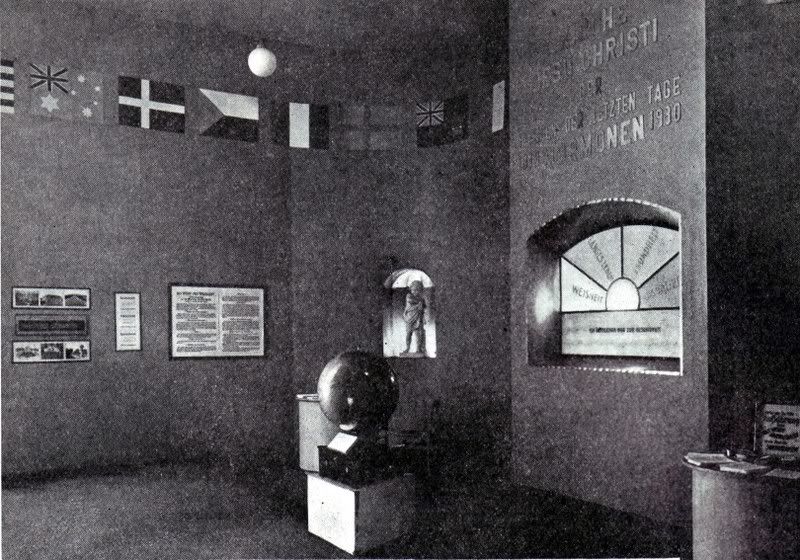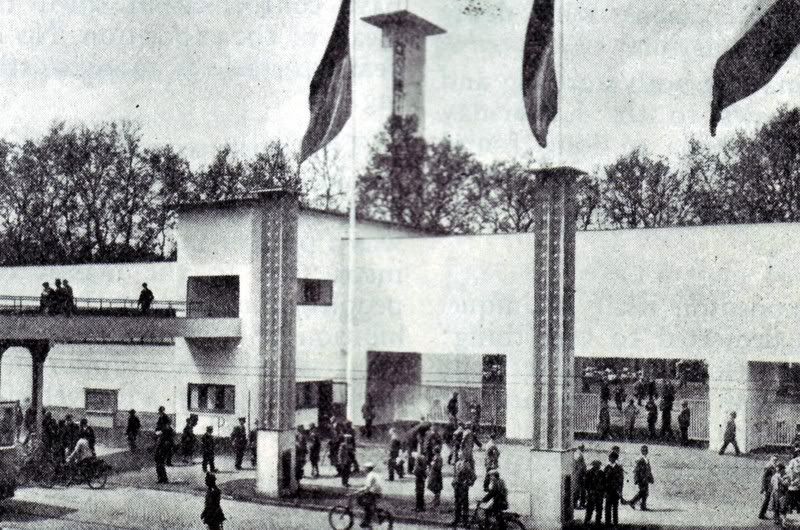 Dresden, Germany was the site of two international hygiene exhibitions (1911 and 1930), World’s Fair-class exhibits dedicated to both the scientific and popular presentation of all issues relating to hygiene: biology, medical advances, mental health, nutrition, disease prevention, exercise, demographics, workplace safety, public morality, child welfare, anything remotely connected to human health.
Dresden, Germany was the site of two international hygiene exhibitions (1911 and 1930), World’s Fair-class exhibits dedicated to both the scientific and popular presentation of all issues relating to hygiene: biology, medical advances, mental health, nutrition, disease prevention, exercise, demographics, workplace safety, public morality, child welfare, anything remotely connected to human health.
Before anyone is sidetracked by wondering: The museum (at right) built for the 1930 exhibit was seized in 1933 by the Nazi Party and its mission was corrupted into racial propaganda; in 1930, though, the displays and goals of the museum were professional, scientific, and comparatively free from political taint. There were presentations on eugenics and racial politics, true, but those topics played small roles in the legion of hygienic displays, and were the subjects of world-wide study independent of what would shortly play out in Germany.
Lectures and visual displays drew millions of local and international visitors. One of the most spectacular exhibits in 1911 was a life-size model of a male body with bone structure and major blood vessels visible beneath its glass skin. The 1930 exhibition is best remembered for its state of the art technology: the use of lights, electrical models, monumental-size panoramic photographs, and movies to display participants’ messages.
The scientific director of the Museum of Hygiene during the run-up to the 1930 exhibition was a Dr. M. Vogel. He was visited in 1929 by Rose Ellen Valentine, president of the Relief Societies of the German-Austrian Mission, and wife of that mission’s President Hyrum W. Valentine. Sister Valentine was seeking material to use in instructing the German sisters concerning the Word of Wisdom and thought that the Museum might furnish the facts and figures she needed.
President Valentine was released that summer, to be succeeded by Edward P. Kimball. Very late that year, Pres. Kimball and Apostle John A. Widtsoe, then acting as president of the european Missions, made a call on A.T. Haeberle, the American Consul at Dresden; one of the subjects they discussed was the upcoming Second International Hygiene Exhibition. The two Latter-day Saints expressed their desire to sponsor a Mormon display at the Exhibition, and Haeberle agreed to assist them in obtaining an invitation to do so. Late in January, the invitation finally arrived – endorsed by Dr. Vogel, who remembered what Sister Valentine had told him about the Word of Wisdom.
Elder Widtsoe believed that the booth he and his colleagues prepared for the Exhibition was the first such exhibit the Church had ever sponsored, at least on so large a scale and in so prestigious a setting. While Elder Widtsoe compiled the statistics that would be discussed in the booth and wrote tracts concerning the Word of Wisdom, to be published in both German and English and made available at the Exhibition, other Latter-day Saints with special skills were called from the missions of Europe to collaborate on the display itself.
The Mormons were given a prime piece of real estate at the front entrance of one of the auxiliary buildings (one sponsored by the League of Nations), and near the exhibits of the International Red Cross.

As visitors entered the room from the main hall, they faced a slowly rotating glass globe, with points of light marking the locations of LDS missions around the world (identified as “places where the Word of Wisdom is taught.”
Beyond the globe was a softly illuminated wall with the name of the church in German (followed by the designation “Mormons”) and the dates 1830-1930 signaling the centennial of the church. Below the name of the church, and positioned so as to appear behind the globe as a rising sun, were panels suggesting the rewards of adherence to the Word of Wisdom: health, long life, wisdom (and others I have not yet found specified). In keeping with the technological dazzle of the entire Exhibition, each of the panels was lighted in turn to draw attention to each reward.
In another not-so-subtle suggestion of the stature of the church, a row of flags circled the room near the ceiling; each flag represented a country in which the church had a presence and was teaching the Word of Wisdom. Posters, photographs and charts on one wall provided information on the Word of Wisdom. On another wall was posted a large chart comparing health conditions of the Latter-day Saints to conditions of the world at large, compiled by Elder Widtsoe and some of which are given below. Take-away literature detailing the economic, mental and moral benefits claimed for the Word of Wisdom was stacked on the counter to the right of the globe.
This photograph shows another feature which I have not found explained (what appears to be the statue of a child in a lighted niche), and I have found the description of one feature which I cannot quite visualize: “a moving, endless, lighted ribbon which tells the story of the Word of Wisdom.”
 Elders, both American and German, from the German-Austrian and Swiss-German missions were stationed at the exhibit to greet guests and answer questions. Average daily attendance was nearly 5,000, with the highest attendance in a single day approaching 30,000. In the first two months, visitors accepted more than 120,000 brochures concerning the church and its health code. Elder Widtsoe reported, “The results of the practice of the Word of Wisdom, imperfectly as the Latter-day Saints have practiced it, are astounding to all, particularly as the hygienic system known as the Word of Wisdom has been tested for nearly one hundred years by a group of people now numbering nearly three quarters of a million people. It is the greatest health experiment in history.”
Elders, both American and German, from the German-Austrian and Swiss-German missions were stationed at the exhibit to greet guests and answer questions. Average daily attendance was nearly 5,000, with the highest attendance in a single day approaching 30,000. In the first two months, visitors accepted more than 120,000 brochures concerning the church and its health code. Elder Widtsoe reported, “The results of the practice of the Word of Wisdom, imperfectly as the Latter-day Saints have practiced it, are astounding to all, particularly as the hygienic system known as the Word of Wisdom has been tested for nearly one hundred years by a group of people now numbering nearly three quarters of a million people. It is the greatest health experiment in history.”
Some of the statistics prepared by Elder Widtsoe, drawn from the 1927 report of vital statistics prepared by the Presiding Bishopric’s Office (the most recent available), and compared with statistics in the then-current yearbook of the League of Nations:
Average birth rate of 25 of the world’s nations: 22 per thousand; of Latter-day Saints: 30 per thousand
Average death rate of those same nations: 14 per thousand; of Latter-day Saints: 7.5 thousand
Deaths per disease comparing Latter-day Saints to the combined nations of Germany, France, the Netherlands, Sweden, Great Britain, and the U.S.:
Tuberculosis: nations, 120 per 100,000; Latter-day Saints, 9
Cancer: nations, 119 per 100,000; Latter-day Saints, 47
Diseases of nervous system: nations, 123 per 100,000; Latter-day Saints, 52
Diseases of circulatory system: nations, 196 per 100,000; Latter-day Saints, 115
Diseases of respiratory system: nations, 167 per 100,000; Latter-day Saints, 105
Diseases of digestive system: nations, 73 per 100,000; Latter-day Saints, 56
Diseases of kidneys: nations, 44 per 100,000; Latter-day Saints, 23
Maternity: nations, 45 per 1000 births; Latter-day Saints, 10
photographs: (top) Deutsches Hygiene-Museum, Dresden; (center) Word of Wisdom exhibit; (bottom) League of Nations building, site of the LDS exhibit
Continue reading at the original source →



